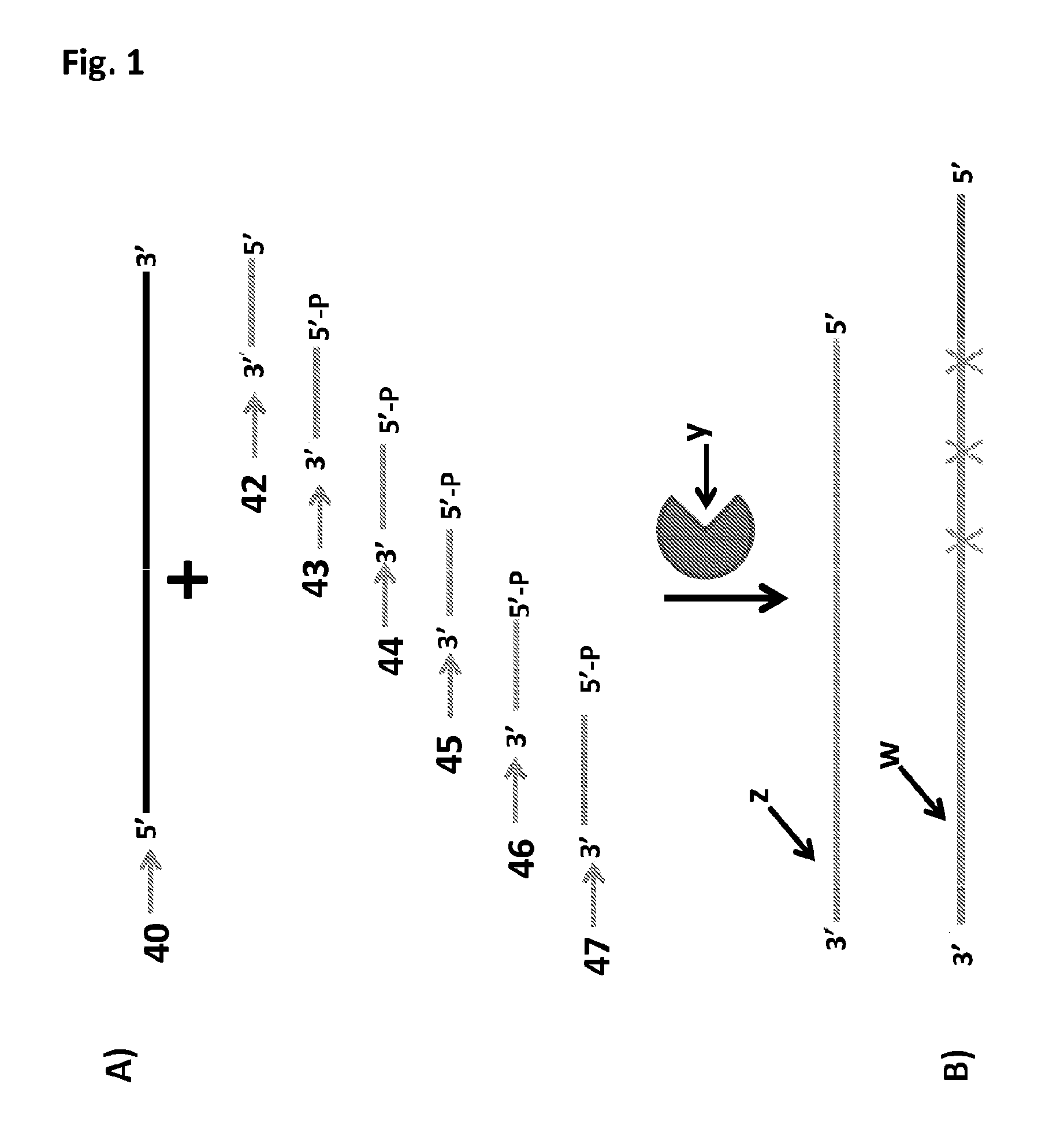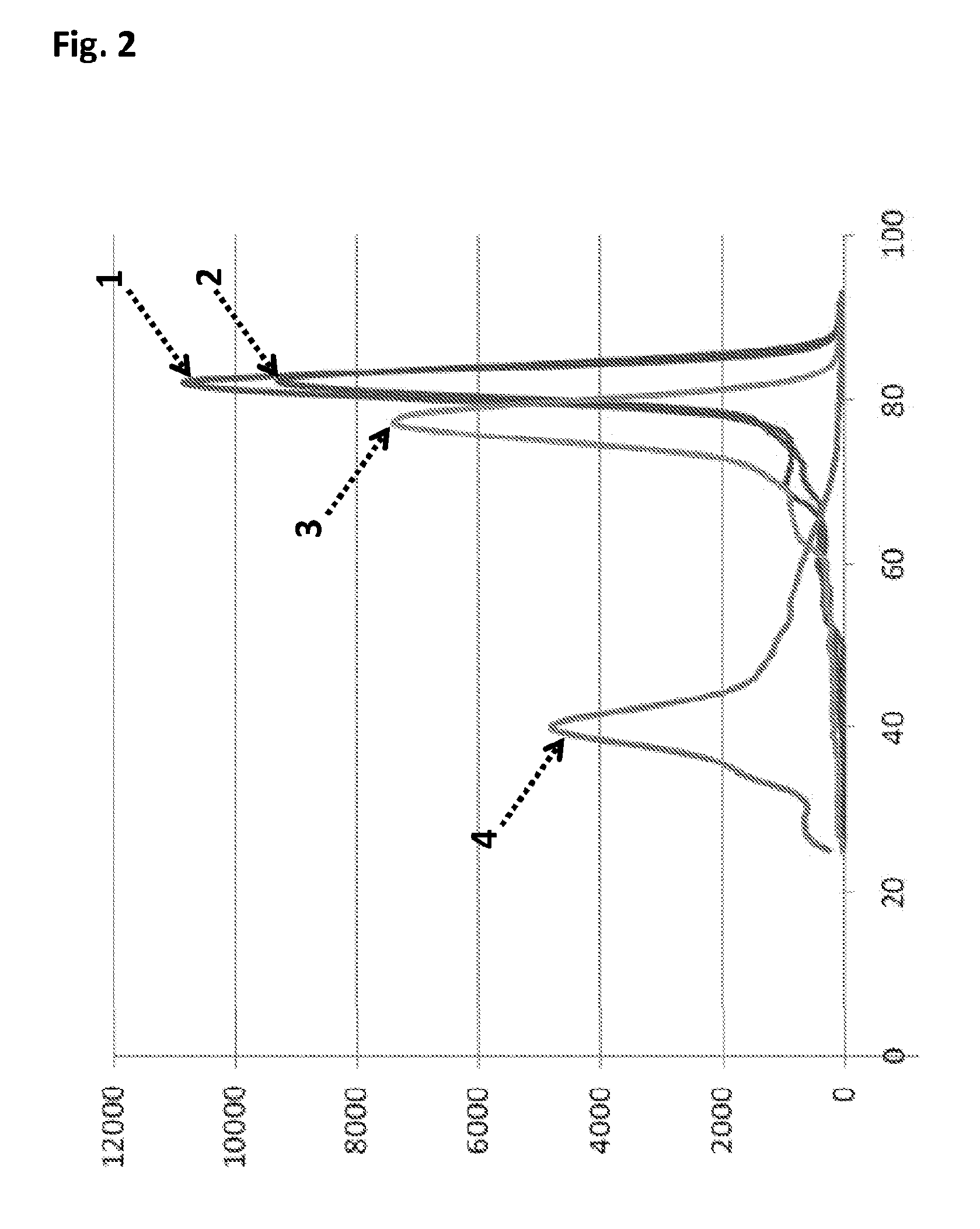Sample preparation method
a template polynucleotide and preparation method technology, applied in the field of characterisation modifying a template polynucleotide, can solve the problems of slow and expensive technology, and achieve the effect of convenient characterisation
- Summary
- Abstract
- Description
- Claims
- Application Information
AI Technical Summary
Benefits of technology
Problems solved by technology
Method used
Image
Examples
example
Example 1
[0360]This example describes the hybridisation of nucleotide oligomers to a sense template polynucleotide strand (SEQ ID NO: 40) and subsequent ligation of the nucleotide oligomers together (FIG. 1).
Materials and Methods
1.1—Ligation Experiments
[0361]For the ligation reactions the sense template strand (SEQ ID NO: 40, 100 pmol) was incubated with the appropriate nucleotide oligomers (all nucleotide oligomers were at 100 pmol) in a 1:1 ratio. Into PCR tubes (0.2 mL) was added the following ligation reaction mixtures, detailed in Table 4 below, and the mixtures were incubated at 16° C. for 18 hours. The experimental samples were then tested for successful ligation by exonuclease digestion and PAGE analysis.[0362]Experiment 1—Sense template (SEQ ID NO: 40)+nucleotide oligomers (SEQ ID NO: 42-47)+No DNA ligase[0363]Experiment 2—Sense template (SEQ ID NO: 40)+nucleotide oligomers (SEQ ID NO: 42-47)[0364]Experiment 3—Sense template (SEQ ID NO: 40)+nucleotide oligomers (SEQ ID NO: ...
example 2
[0376]This example describes the hybridisation of nucleotide oligomers, which contain abasic residues, to a sense template polynucleotide strand (SEQ ID NO: 40) and subsequent ligation of the nucleotide oligomers together (FIG. 5).
Materials and Methods
2.1—Ligation Experiments
[0377]For the ligation reactions the sense template strand (SEQ ID NO: 40, 100 pmol) was incubated with the appropriate nucleotide oligomers (all nucleotide oligomers were at 100 pmol) in a 1:1 ratio. Into PCR tubes (0.2 mL) was added the following ligation reaction mixtures, detailed in Table 6 below, and the mixtures were incubated at 16° C. for 18 hours. The experimental samples were then tested for successful ligation by exonuclease digestion and PAGE analysis.[0378]Experiment 1—Sense template (SEQ ID NO: 40)+nucleotide oligomers (SEQ ID NO: 46 and 54)[0379]Experiment 2—Sense template (SEQ ID NO: 40)+nucleotide oligomers (SEQ ID NO: 45, 46 and 54)[0380]Experiment 3—Sense template (SEQ ID NO: 40)+nucleotide o...
example 3
[0399]This example describes the hybridisation of nucleotide oligomers, which contain deoxyinosines, to a sense template polynucleotide strand and subsequent ligation of the nucleotide oligomers together (FIG. 9).
Materials and Methods
3.1—Ligation Experiments
[0400]Oligos were annealed to create the 3 fragment structure shown in FIG. 9 (two antisense strands ligated to a sense strand to generate a nick to be repaired). The following reaction mixtures, detailed in Table 8 below, were prepared for the experiment sets described below. Oligos were annealed by heating to 98° C. for 2 minutes before being cooled to 18° C. at 2° C. per minute.[0401]Experiment 1—positive control sense template (SEQ ID NO: 55)+positive control 5′ antisense strand (SEQ ID NO: 56) and positive control 3′ antisense strand (SEQ ID NO: 57)[0402]Experiment 2—negative control sense template (SEQ ID NO: 55)+negative control 5′ antisense strand (SEQ ID NO: 56) and negative control 3′ antisense strand (SEQ ID NO: 57) in...
PUM
| Property | Measurement | Unit |
|---|---|---|
| voltage | aaaaa | aaaaa |
| voltage | aaaaa | aaaaa |
| voltage | aaaaa | aaaaa |
Abstract
Description
Claims
Application Information
 Login to View More
Login to View More - R&D
- Intellectual Property
- Life Sciences
- Materials
- Tech Scout
- Unparalleled Data Quality
- Higher Quality Content
- 60% Fewer Hallucinations
Browse by: Latest US Patents, China's latest patents, Technical Efficacy Thesaurus, Application Domain, Technology Topic, Popular Technical Reports.
© 2025 PatSnap. All rights reserved.Legal|Privacy policy|Modern Slavery Act Transparency Statement|Sitemap|About US| Contact US: help@patsnap.com



